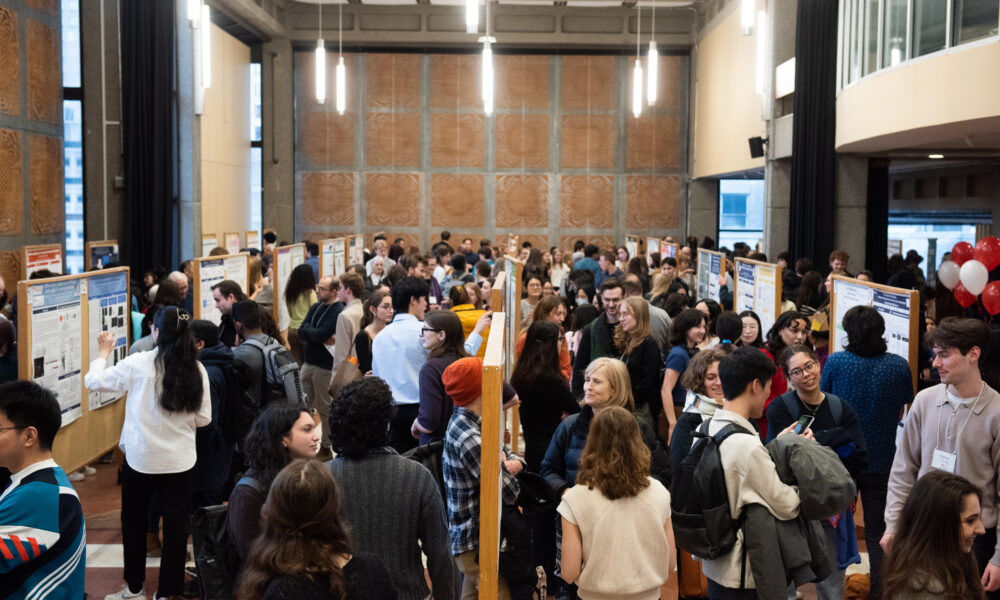On March 19, McGill’s Office of Science Education hosted its fifth annual Undergraduate Poster Showcase in the University Centre Ballroom, providing students with an opportunity to share their research, passion projects, and in-class work. This year, the event featured 150 colourful posters rich with information, images, and creative interpretations of science.
The Tribune spoke to undergraduate students Michelle Kowalska, Evonne Henning, and Emma Tomiuk about their research.
Exploring LGBTQ+ substance recovery
“Unfortunately, LGBTQ+ individuals may be at higher risk of struggling with substance misuse compared to their cisgender and heterosexual peers, mainly due to social and systemic factors, such as homophobia, transphobia, and discrimination,” Kowalska, U3 Arts, explained in her poster presentation.
For Kowalska, this heightened risk of substance misuse points to the importance of creating inclusive support services and recovery programs that are responsive to the needs of LGBTQ+ people. It is also essential to understand their personal experiences of substance misuse and recovery.
“To be able to investigate that, we conducted semi-structured interviews with LGBTQ+ individuals to discuss questions such as what is substance misuse and what is abstinence versus recovery,” Kowalska continued.
Her findings suggest the need to broaden traditional definitions of recovery to encompass LGBTQ+ perspectives and highlight the impact of intersectional factors such as race, gender, ethnicity, and socioeconomic status on recovery experiences.
Kowalska’s study also calls for further research into LGBTQ+ recovery experiences, particularly the intersections of identity and recovery, to better understand and support the needs of these communities.
Partial versus total knee replacement in patients with knee osteoarthritis
In Canada, roughly 55,000 knee replacements are performed each year. Around 90 per cent of these are total knee replacements, with partial knee replacements making up the rest.
Knee replacement surgery involves replacing parts of injured or worn-out knee joints with an artificial implant. It is one of the most recommended surgeries for knee osteoarthritis—a condition that reduces one’s ability to move freely by causing pain, swelling, and stiffness in the knee joint.
“A partial knee replacement preserves the anterior cruciate ligament, which is a ligament that controls the motion of the knee, but a total knee replacement removes this ligament,” Henning, U3 Science, said in her talk. “A partial knee replacement is [also] less invasive, heals faster, and has a shorter operation time.”
Given the advantages of partial replacements over total knee replacements, Henning’s team aimed to quantify the differences in knee function between patients who undergo the former surgery and those who undergo the latter.
Henning did not observe statistically significant differences between the two groups of patients in terms of pain, stiffness, and physical function.
“This suggests that a partial knee replacement could be a potential alternative to total knee replacement for patients with knee osteoarthritis,” Henning said.
Student motivation changes and relation to learning
Expectancy-value theory is one of the most influential theories for understanding motivation. One component of this theory, cost, can be defined as the extent to which a student needs to sacrifice to perform a task.
“[According to expectancy-value theory,] there are three types of cost—psychological cost, effort cost, and opportunity cost,” Tomiuk, U3 Arts and Science, said in her poster presentation.
Tomiuk is dedicated to studying the changes in motivation of McGill undergraduate students throughout the semester and whether motivation levels can predict students’ grades.
Another component of the theory is value, defined as the extent to which the individual values the desired outcome. Value can be further categorized into interest value (personal enjoyment), utility value (perceived usefulness for future goals), and attainment value (the importance of achieving the outcome).
Self-efficacy, one’s belief in one’s capacity to achieve a goal, also plays a crucial role in controlling motivation.
“We found that costs and attainment value decrease over time, whereas self-efficacy and interest value increase over time,” Tomiuk said. “Lower costs and higher self-efficacy predict higher grades.”
Tomiuk suggested that future research could focus on the impact of students’ learning environment on their motivation.









